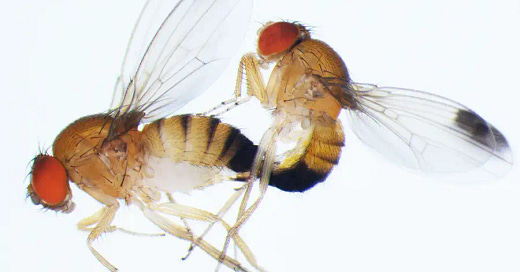by Richard Conniff
Background Note: It’s odd how stories sometimes develop. This one got its start on a trip to Costa Rica in 2000 to write about spider webs for National Geographic. I’d heard that Bill Eberhard at the University of Costa Rica and the Smithsonian Tropical Research Institute was the great expert on spider webs. We’d arranged to meet at La Selva Biological Station, where he took me on a tour of what spiders can do with their webs, which was utterly astonishing. But that’s another story. (You can read it in my book Swimming With Piranhas at Feeding Time). Eberhard also turned out to be extremely knowledgeable about the genitalia of spiders and other creatures, and about something he called “covert female choice.”
It was still good times in magazine publishing then, and I was constantly bashing from place to place on one story or another, and also working on books. But the “amazing genitalia” idea stayed with me. It came back to mind on a 2006 trip to Madagascar, during a woolly lemur autopsy described below. So I wrote the story that I am finally publishing this week. It wasn’t the sort of thing I could publish in Smithsonian or National Geographic, as you might imagine. (It had been a small triumph just to publish the word “condom” in a 1995 story, for the first time ever in Nat Geo’s history, and the word “schtup” at about the same time in Smithsonian.) So I eventually took “Amazing Genitalia” to another magazine, which will remain nameless because the story appeared in a bastardized version. Not my editor’s fault. He knew what the magazine needed, and so did I. So I revised as requested, because what I needed was to pay my kids’ college tuition. But it pleases me now to publish the original version this week, as I intended it.
It looked like a penis, only smaller
Oh, and with claws on the sides.
The carcass, a monkey-like species called the woolly lemur, was laid out on a dissecting table at a research station in Madagascar. A goshawk had killed it the day before and stripped it to the bone from the waist up.
“Here’s the intestine. You can see where it was ripped off,” said the biologist. She had the unsqueamish enthusiasm of a Girl Scout crossed with a dental technician. Then she reached into the fur and delicately drew out the penis. It was almost human in shape, except for the two claws, about a third of the way down from the tip. When she tapped them with her dissecting tool, they made a hard, clicking sound. “Like cat claws,” the biologist remarked, and a shudder passed through the room. One earnest onlooker asked if the claws perhaps helped the male hang onto the female, to keep rival males from taking his place? “But woolly lemurs live in monogamous pairs,” the biologist said. Someone else wondered if woolly lemurs perhaps like it … rough?
It was a weird little moment. But, fair warning, it gets much weirder.
The animal world is full of genitalia which strike even biologists as too bizarre to have evolved solely for the relatively straightforward business of passing sperm from male to female. We’re not just talking about the obvious stuff: Everybody who watches Animal Planet already knows, for instance, that sharks typically come with two penises. Avid naturalists may also know that in hyenas, where females are the dominant gender, the clitoris has evolved to look like a penis, and that one female approaching another will often display a prominent erection.
But that sort of thing seems normal, almost, compared with what biologists find when they look a little closer, particularly at some of the more obscure members of the Wild Kingdom. Under the covers in this strange world are genitalia that give rich new meaning to the concept of kinky.
There are, for instance, hermaphroditic snails which mate as male and female simultaneously and, just to keep things interesting, also jab spears and darts into each other’s genitalia.
There’s a fish which inserts a siphon into the female, then squirts seawater out the tip in a spiral rotary motion. (It’s a contraceptive douche, to dislodge the sperm of other males that have gotten there before him.)
There’s a beetle with a penis like a folded umbrella. Once snugly ensconced within the female, it pops opens. Nobody knows if the idea is to stimulate her, or to irritate her so much she never wants to mate again.
Animals inhabit a giddy world of female parts full of twists, turns, and corkscrew spirals, and male parts studded with bumps, knobs, hooks, ridges, valves, and french ticklers. Vladimir Nabokov, who liked to pin out butterflies when he wasn’t writing novels, once described the genitalia of his study subjects as “sculpturesque.” Biologist Marlene Zuk has likewise celebrated genitalia that “resemble bits of the decorations on Old World cathedrals.” Charles Darwin himself enthused over a barnacle penis lying “coiled up, like a great worm,” which when “fully extended … must equal between eight or nine times the length of the animal.”
But the study of genitalia isn’t merely weird and entertaining. It has become one of the hottest topics in modern biology because it also casts a revealing light on the relationship between male and female. Is the act of sex, as we like to imagine, a moment of extraordinary intimacy and cooperation between the sexes? Or is it just a way of making war by other means, a struggle marked by conflict, manipulation, exploitation, and mayhem?
In tomorrow’s episode, the topics will include the “Chinese finger trap” alignment of male and female June Bug genitalia, and also Henrietta Darwin’s odd obsession with spearing and incinerating specimens of the mushroom whose name means “shameless penis.”




